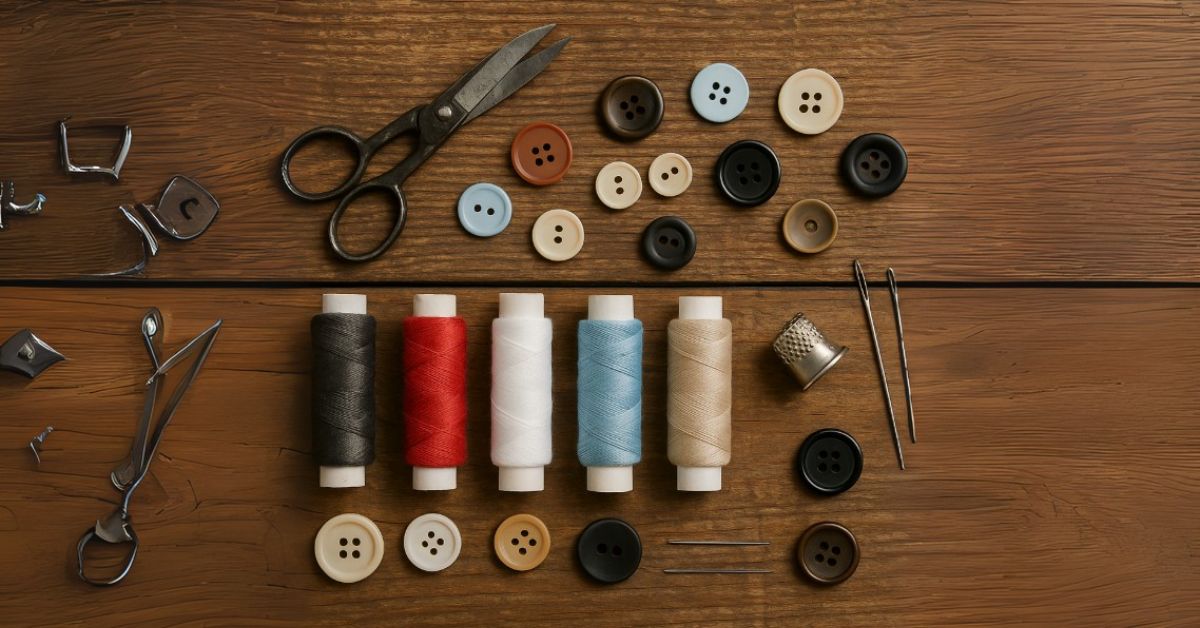Learn how to sew a button by hand like a pro! Follow our step-by-step guide for flat and shank buttons, avoid common mistakes, and explore expert tips and FAQs to fix clothes with confidence.
Table of Contents
Why Sewing Buttons is a Lifesaving Skill?
We’ve all been there—a button pops off your favorite shirt just before an important meeting. Quick fixes with glue or tape rarely hold up. Knowing how to sew a button by hand the right way not only saves you time and money but also spares you the frustration of last-minute wardrobe emergencies. This 3,000-word guide combines professional tailoring techniques with beginner-friendly steps. Whether it’s a 2-hole, 4-hole, or shank button on denim, silk, or wool, you’ll gain the confidence to repair garments securely.
Fun fact: Did you know that 80% of button failures happen because they were sewn poorly? Mastering the “thread shank” technique—especially important for thick fabrics—can make your buttons last even longer than the garment itself. Ready to learn? Let’s begin!
I. Materials You’ll Need (No Fancy Tools!)
Before you start, gather these simple household items:
Button: Match size/color to originals. Tip: Keep spare buttons from new clothes!
Needle: Sharp “sharps” needle (size 7–10) for woven fabrics.
Thread: Polyester or cotton-wrapped polyester (e.g., Gutermann). Use doubled thread for
strength.
Scissors: Small, sharp ones for clean cuts.
Optional: Thimble (protects fingers), toothpick (for shank), fabric chalk.
Pro Tip: Choose a thread color that matches the button—not the fabric—for the most discreet repair. For extra durability, use button hole twist thread, which is stronger and perfect for sewing buttons. (Source: Thread Selection Guide)
II. Step-by-Step Guide:
Sewing a Flat Button (2 or 4 Holes) Perfect for shirts, pants, and light jackets.
Step 1: Prepare the Thread
Cut about 24 inches of thread and insert it through the needle’s eye.
Fold it in half, aligning the ends, then tie a secure double knot to create a doubled thread.
Step 2: Position the Button
Place the button over its original spot. If the old marks have faded, lightly mark with fabric chalk.
Bring the needle up from the back side of the fabric, through one hole in the button.
Leave about 1 inch of thread at the back.
Step 3: Make Anchor Stitches
Sew down through the diagonal or opposite hole. Repeat this 2–3 times to anchor the button.
Important: Keep your stitches loose for now—don’t pull the thread tight yet.
Step 4: Create a Thread Shank
This step adds flexibility and helps prevent puckering.
Place a toothpick horizontally on top of the button, under the stitches.
Sew 4–6 stitches tightly over the toothpick.
Step 5: Finish & Secure
Carefully remove the toothpick. Lift the button to reveal a small space underneath—the shank.
Wrap the thread firmly around the shank 6 times.
To finish, push the needle to the fabric’s backside, loop the thread twice, pull tight to form a knot then trim any excess.
III. Sewing a Shank Button (The Easy Way) For coats, bags, and thick fabrics.
Shank buttons have a loop instead of holes:
Anchor thread on the fabric back. Bring the needle up through the shank loop.
Sew down ⅛ inch from the entry point. Repeat 8–10 times.
Skip the toothpick! The metal loop acts as a built-in shank.
Knot thread on the backside under dense stitches.
Warning: Shank buttons must sit slightly raised. Flat stitching strains the fabric.
IV. 5 Common Mistakes & Pro Fixes
Thread Tangling? Run through beeswax or use shorter lengths.
Fabric Puckering: You skipped the shank. Always use a spacer (toothpick/pin).
Weak Hold: Used a single thread. Always double thread for durability.
Button Too Tight: Leave wiggle room. Buttons should slide under fabric easily.
Wrong Needle: Ballpoint needles for knits (Needle Guide).
V. Advanced Tailoring Secrets
Heavy Fabrics (Denim/Coats): Use upholstery thread. Stitch an “X” backing with interfacing.
Silk/Delicates: Sandwich with tear-away stabilizer to prevent pulls.
Decorative Stitches: For 4-hole buttons, try parallel lines, cross pattern, or square weave.
Reinforce Stress Points: Sew buttons at stress points (cuffs, waistbands) with 10+ stitches.
VI. FAQs (Answered by Tailors)
Q: How long should my thread be?
A: 24 inches max. Longer threads tangle and weaken.
Q: Can I use dental floss in a pinch?
A: Yes—but only for temporary fixes. It degrades faster than polyester thread.
Q: Why does my button keep falling off?
A: You didn’t knot securely. Use the “loop knot” method shown in Step 5.
Q: How many stitches are enough?
A: 5–6 for light fabrics, 8–12 for heavy materials.
Conclusion: Your Button-Sewing Superpower
Sewing buttons by hand isn’t just practical—it’s empowering. In 10 minutes, you’ve learned techniques that outlast store-bought repairs. Remember: the thread shank is non-negotiable for durability, and doubled thread is your secret weapon. Practice on an old shirt, then rescue that favorite coat from the donation pile.





